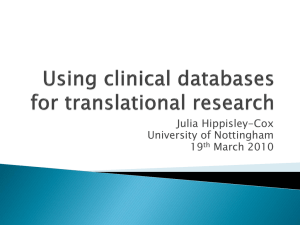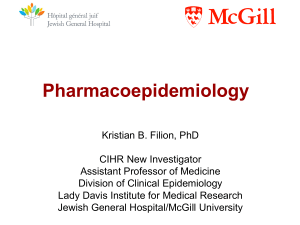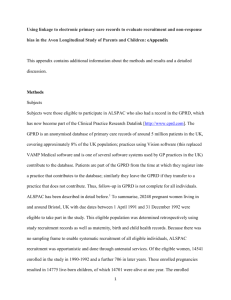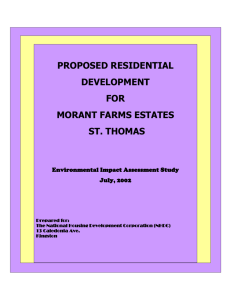Databases - National Therapy Centres
advertisement
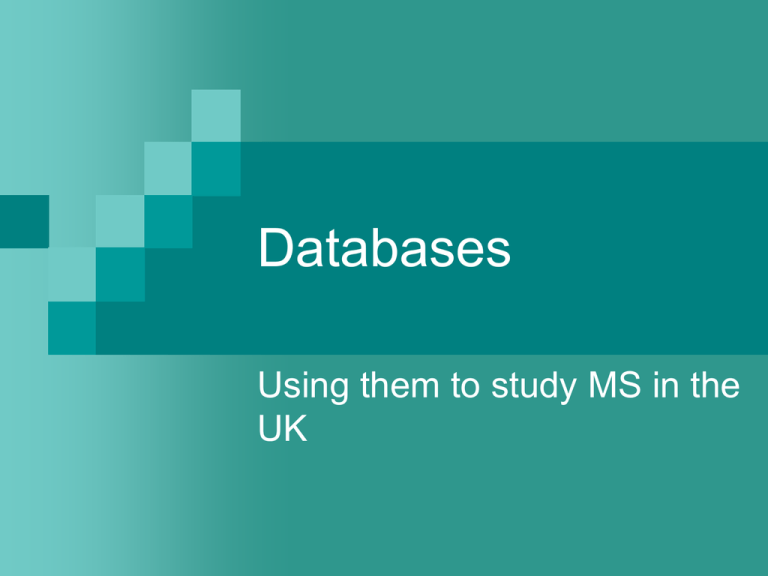
Databases Using them to study MS in the UK Proposed research using: GPRD (General Practice Research Database) MSNTC Northwood Database Epidemiology Prevalence - how many people are living with MS? Incidence - how many people are newly diagnosed with MS every year? Factors affecting MS – gender, age, ethnicity, region Trends – how MS epidemiology changes over time Why does it matter? Greater understanding of MS in the UK Allocation of resources – nationwide and regionally Having a voice – not a ‘hidden disease’ Epidemiology of MS is not well understood Limited information available compared to other diseases e.g. cancer, diabetes Estimated prevalence of 85,000 by extrapolating data from a series of local studies MS Society funded survey in 2009 UK prevalence study June 2009 First national project based on the best evidence available Showed that there are about 100,000 people with MS in the UK Researchers at the London School of Hygiene and Tropical Medicine used data from the General Practice Research Database (GPRD) to estimate of the number of people with MS in the UK What is GPRD? Contains patient records from 6% of GP practices in the UK Anonymous patient data The world’s largest primary care database Used by academics around the world to study different diseases GPRD published studies 160 papers 2009 to 2011 Drug treatment discontinuation and achievement of target blood pressure and cholesterol in United Kingdom primary care. MacDonald TM, Morant SV, Mozaffari E Curr Med Res Opin 2007 23(11) 2765-74. Treatment patterns for hypertension, dyslipidaemia, and both conditions in the United Kingdom: 1997-2001. MacDonald TM, Morant SV, Baker CL, Mozaffari E Pharmacoepidemiology & Drug Safety (2004) 13: S237-8 Treatment of high-risk hypertensive patients in the United Kingdom: 1997-2001 MacDonald TM, Morant SV, Baker CL, Mozaffari E Pharmacoepidemiology & Drug Safety 2004 13: S103 Low treatment rates and poor goal attainment in patients with concomitant hypertension and dsylipidaemia: data from the United Kingdom MacDonald TM, Morant SV, Baker CL, Mozaffari E Pharmacoepidemiology & Drug Safety 2004 13: S29-30 Increased rates of diagnosis for hypertension or dyslipidaemia in patients previously identified with one of these risk factors: data from the United Kingdom MacDonald TM, Morant SV, Mozaffari E Pharmacoepidemiology & Drug Safety 2004 13: S302-3 New analyses of MS using GPRD In collaboration with University of Dundee Access to database Input from epidemiologists + neurologist Statistical analyses performed by Dr Steve Morant Written for publication in peer-reviewed journal by Dr Glenys Bloomfield What can GPRD tell us? Numbers of people with MS prevalence incidence trends over last decade Who is affected? gender age region What can GPRD tell us? Treatment of MS hospital referrals drug prescriptions co-morbidities GP contacts Proposed research using: GPRD (General Practice Research Database) MSNTC Northwood Database MSNTC stats We already record the number of Individual sessions of O2T Members receiving therapy – MS/non-MS New members - MS/non-MS MSNTC stats - Northwood database Much easier and more efficient method of collecting data We can collect a lot more detailed information on various therapies and who uses them Useful for fundraising and raising the profile of Therapy Centres – individually and nationally What else can the MSNTC database tell us about MS? We have a major resource MSNTC GPRD ~10,000 members ~ 20,000 MS patients We can learn important information about the role of non-drug therapies in symptom management Treatment records Treatment records can be entered for each member The system will calculate MSIS-29 results (average answer to each question) MSIS-29 trends (improvement/no change/decline) for each question MSIS-29 Form Tried and tested: the psychometric properties of the multiple sclerosis impact scale (MSIS-29) in a population-based study Multiple Sclerosis Journal January 2009 vol. 15 no. 1 75-80 The MSIS-29 is an acceptable, reliable, and valid method of recording quality of life. A significant relationship between higher physical impact scores of the MSIS-29 and higher Kurtzke EDSS values suggests that it may be of use in clinical trials to monitor progression. MSIS-29 Form The multiple sclerosis impact scale (MSIS-29) is a reliable and sensitive measure J Neurol Neurosurg Psychiatry 2004;75:266–269 The psychometric properties of the MSIS-29 are acceptable; it is a valuable outcome measure in intervention studies of patients with MS. What can we do with this data? With the help of Centres and their members we can collect information on the progress of individual members over time in a format that is accepted by the medical community When we have enough data we can analyse the effects of different non-drug therapies on the progress of MS using anonymous records from our database Conclusions We have an opportunity to make important contributions to our understanding of MS using these resources GPRD - epidemiology of MS in the UK, drug treatments MSNTC Northwood database – role of Therapy Centres and non-drug therapies Conclusions This will help ensure that MS receives the recognition and resources that it needs It will raise the profile of the MS Therapy Centres and establish us as professional and credible members of the MS community
